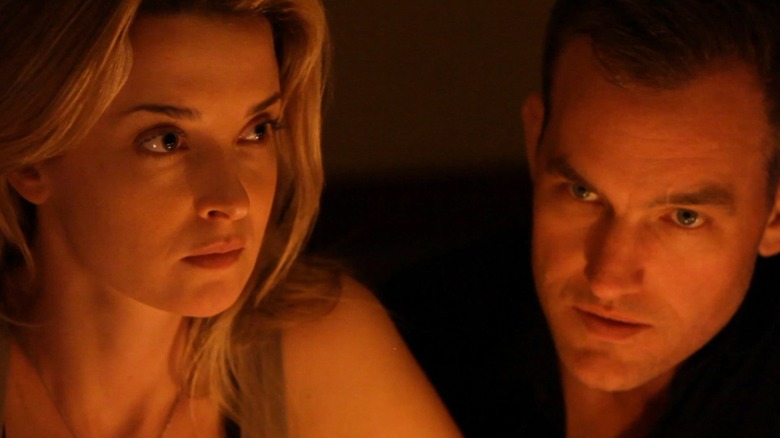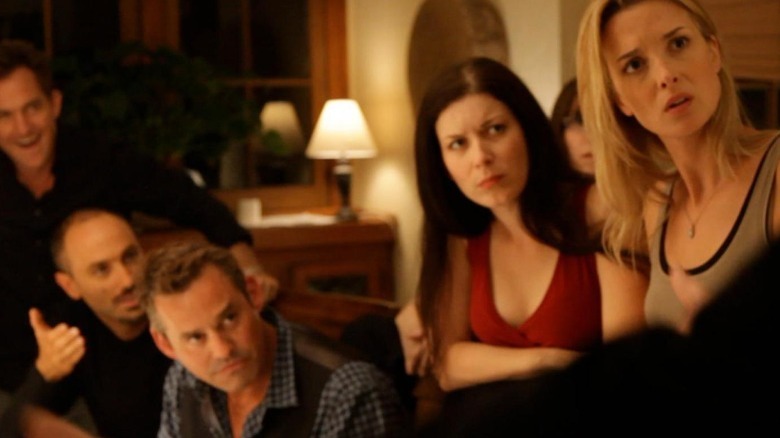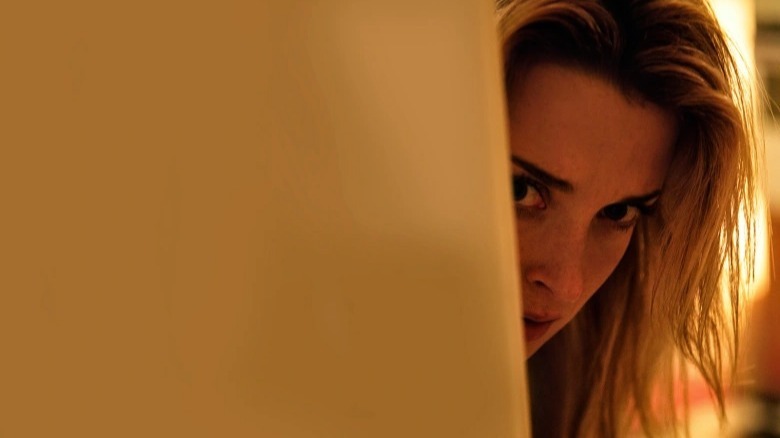The Cast Of Coherence Was Just As Baffled As The Audience
James Ward Byrkit's "Coherence" is the kind of sci-fi psychological thriller that leaves audiences with more questions than answers by the time the film ends. Shot on a shoestring budget and with actors who are close friends with Byrkit, 'Coherence" starts with the simple premise of eight friends having dinner together on the night of a comet passing. While audiences are treated to some staple tropes associated with the sci-fi genre (including disrupted cell service, power blackouts, and increasingly strange occurrences), "Coherence" remains unpredictable right until the end. As the narrative essentially deals with alternate dimensions created by a rip in space-time, one would assume that the actors were thoroughly aware of their complex character arcs as the film progresses. However, this was not the case.
In an interview with Yahoo Movies in 2014, Byrkit delved into some of the theories posited to explain the complicated turn of events in "Coherence," and how the actors were as much in the dark as audiences during filming. Part of the reason why the film emerges as such a compelling watch is the naturalistic way in which the characters communicate and how random actions/events carefully tie together to create a composite whole by the end. Byrkit, along with his co-writer Alex Manugian (who also plays Amir), deliberately created a "funhouse" environment for the actors while providing them room to put the pieces of the puzzle together and improvise on the spot.
Unbeknownst to them, though, they were also a part of a deliberate, thrilling puzzle box crafted by Byrkit and Manugian, which made the experience more authentic and one-of-a-kind.
An extremely unconventional filming process
The crux of "Coherence" is the relationship between eight friends, whose dynamic with one another alters and unravels during the fateful night of Miller's comet. Although the believability of the narrative hinged completely on the chemistry among the group, James Ward Byrkit decided to invite eight friends who did not know one another to his house with "no knowledge of what [they] were doing."
In the aforementioned interview, the director explained that while he and Alex Manugian had worked on the film's core idea for over a year, the actors were neither given a brief about their characters nor handed a working script. They just trusted Byrkit enough to show up at his house (where the entire film was shot) and plunge themselves into an experience like no other. This type of unconventional filming approach could have gotten especially tricky, given that the plot features multiple versions of the same character. But somehow, the cast of "Coherence" managed to make it work.
So, how did they go about making the movie? Byrkit explained that every actor was given "a page of notes for what they had to do" every day, which included snippets of character backstory, possible motivations, and vague acting directions. For instance, an actor would be provided with the note "Somehow, get outside tonight," and they would improvise this while being unaware of what anyone else what told to do. This would produce startling effects, genuine reactions, and naturalistic dialogue, which enhanced the chaos of "Coherence" in remarkable ways. The actors also were unaware of the many power outages that were supposed to be an essential aspect of the alternate reality phenomenon, which made their shared experience seem more authentic.
Coherence is a taut, masterful character study
There are no knee-jerk moments or jump-scares in "Coherence." In fact, the horrifying aspect of the premise emerges from the idea of being confronted with mirrored realities and selves, and what one is ready to do to escape to a version one deems "better." The film tackles the themes of identity, both in terms of self-perception and how one is perceived among a group, and how willing we are to quickly make choices without considering the long-term repercussions. Interestingly, the cast of the film had pieced together these overarching themes by the time shooting was finished, and the significance of certain in-film events — such as the contents of the box in each house — made sense to them gradually over time.
Byrkit explained that the cast also "didn't know what the glow sticks meant" or "when a fight was going to break out," as they were not aware of the notes that their co-stars had received. This allowed individual actors, such as Emily Foxler (who plays the film's lead), to authentically carve out their own arcs and explore the complexities as and when they arose. Notes given to the actors would include cues like, "How would a person with said character traits realistically behave in a certain situation?" and "What real-world movie reference would they make to make sense of the situation?" to bolster immersion and believability.
That being said, the seemingly-randomized and improvised nature of filming does not mean that James Ward Byrkit and Alex Manugian neglected to painstakingly map out confusing events, alternate versions of characters, or key character choices in advance. The film's actors, although urged to participate in an experimental environment, were constantly a part of a "controlled funhouse" that was designed exclusively for them. The results are glorious.


